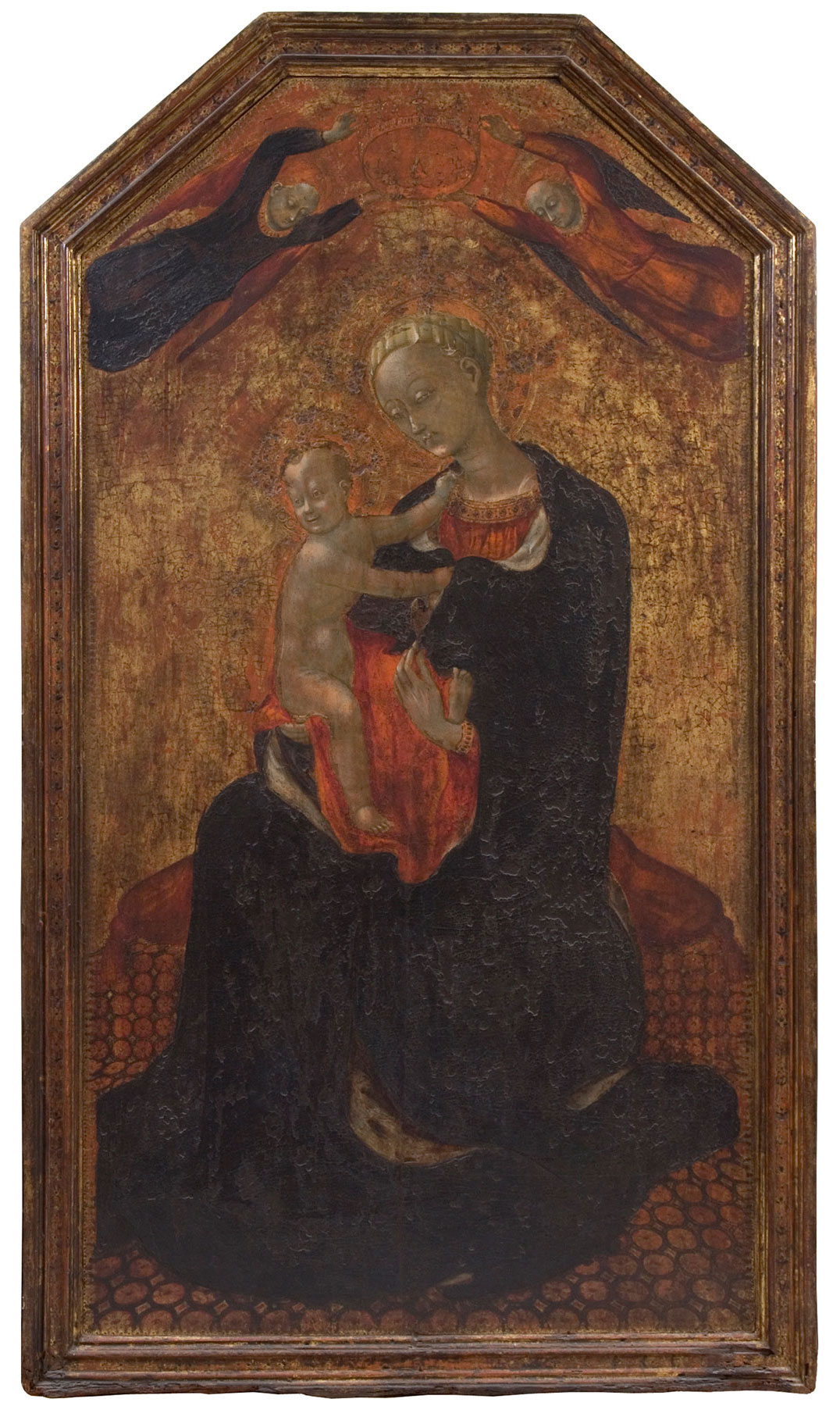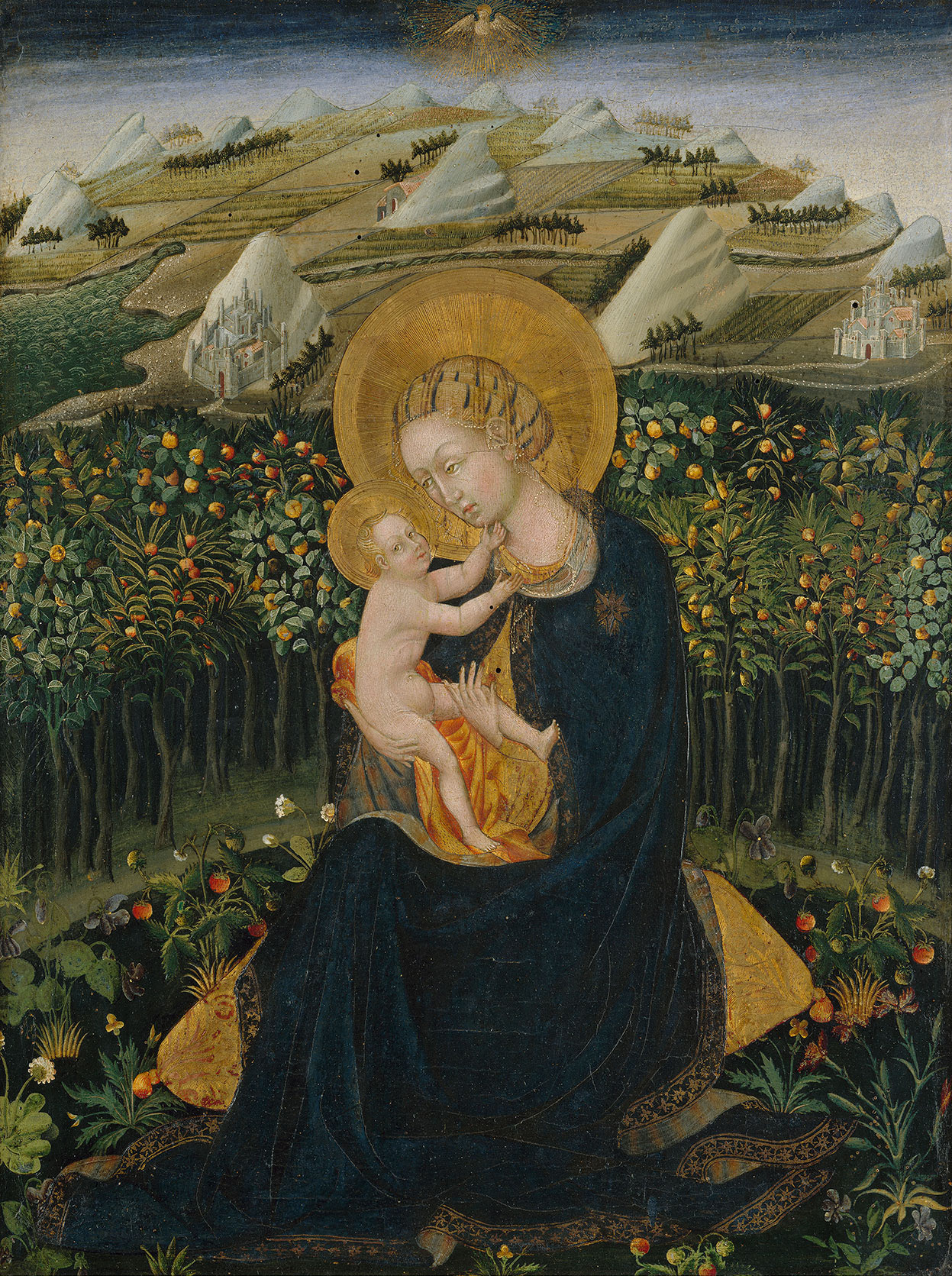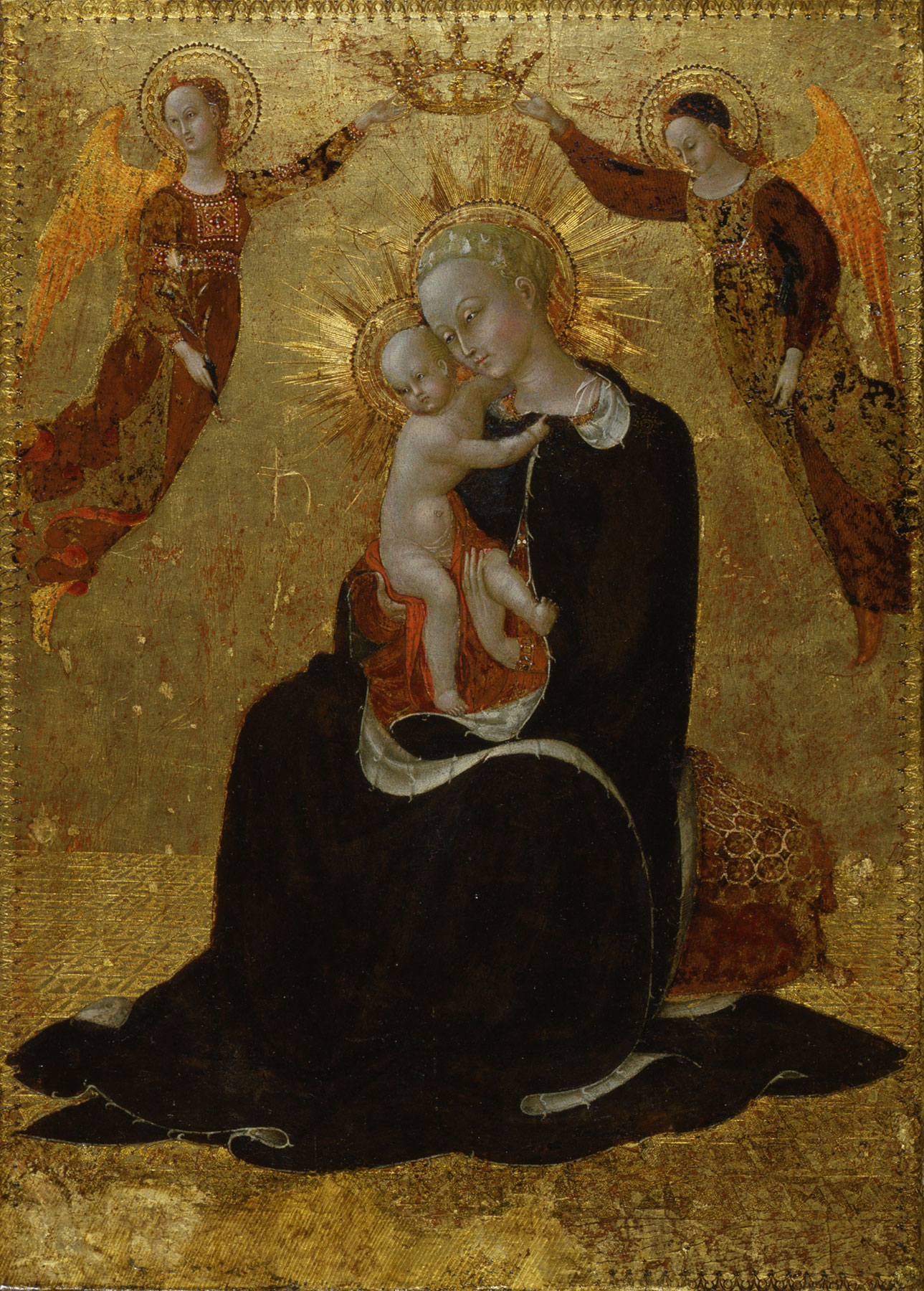Dr. Cottin, Paris; art market, New York; Maitland Fuller Griggs (1872–1943), New York, 1926
The panel, of a vertical wood grain, retains its original thickness of 2 centimeters but has been waxed and cradled. The engaged frame, 1.5 centimeters thick, is original and undisturbed, other than by lifting at the lower-right corner. Partial splits have developed in the panel at 11, 18.5, and 25 centimeters from the left edge but have resulted in no appreciable paint loss. A disturbance in the panel grain from a knot in the lower-left corner, 12 centimeters from the left edge and 7 centimeters from the bottom, has opened several small cracks in the paint surface. The gold ground is beautifully preserved, with minor repairs to losses along the top edge of the frame on all sides, the sight edge at the top center, and the open miter at the bottom-right corner. Small retouches fill flaking losses along the craquelure above the haloes of the Virgin and Child, to the right of Saint Bartholomew’s chin, and along the top half of the right punched margin of the composition. The paint surface is lightly and evenly abraded from an aggressive cleaning of 1953. Small flaking losses have been compensated in the Virgin’s blue robe and Saint Bartholomew’s gray cloak. Decorative glazes over gold have flaked in the Virgin’s left sleeve and at her breast and in Bartholomew’s rose-colored robe.
There is no published record of this painting before its acquisition by Maitland Griggs in New York in 1926, though he was informed at the time of purchase that it had formerly belonged to a “Dr. Cottin,” the Rothschild family physician, in Paris. Richard Offner, in a lecture at the Griggs home in 1927, said that it displayed “the formula of Giovanni di Paolo, but not his style.”1 That same year, it was published by Raimond van Marle as by Giovanni di Paolo but without comment on its possible dating or comparison with other works.2 Bernard Berenson and Marialuisa Gengaro similarly listed it as by Giovanni di Paolo without comment.3 John Pope-Hennessy adduced it as a measure of Giovanni di Paolo’s interest in Sassetta and as a gauge of the progress of his style after a group of paintings that he associated with the Madonna of Mercy altarpiece of 1431 in the church of the Servi in Siena, the signature and date on which had, at that time, been altered by restoration to read 1436.4 Cesare Brandi, in a derisive riposte to Pope-Hennessy, dismissed the Griggs painting altogether (“da togliersi recisamente a Giovanni di Paolo”), describing it as only vaguely attuned to the artist’s manner.5 He nevertheless, and confusingly, included it in the summary list of works by Giovanni di Paolo appended to the end of his monograph.6 Charles Seymour, Jr., also expressed doubt about the autograph status of the painting, qualifying it as a workshop production and as “later than ca. 1436,” apparently in acknowledgment of Pope-Hennessy’s observations.7 Everett Fahy, in a manuscript opinion, attributed the painting to Pellegrino di Mariano, but Federico Zeri and Carl Strehlke (in his unpublished checklist of Italian paintings at Yale, where he called it a work of the 1450s) both recognized it as autograph.8

Beyond a tendency in earlier scholarship to assess Giovanni di Paolo’s work by the reductive standards applied to trecento artists, it is difficult to understand the basis for any doubt about this painting’s authorship. It is so thoroughly redolent of the forms, palette, technique, and style of Giovanni di Paolo as to leave room only for questioning its date and unusual format. The engaged frame surrounding the painting is original and unaltered, showing no evidence of missing attachments along any side. The continuous profile of the frame—identical along all sides of the painting—implies that the work was always intended to function as a stand-alone object of private devotion, and lacking shutters to close over and protect the central image, it might be assumed to have been painted for a specific context and was not meant to be portable. Its remarkable state of preservation—aside from an aggressive modern cleaning—could suggest that it was inserted into a marble tabernacle surround (which might have had its own protective shutters), similar to that hypothesized for the much larger painting by Sassetta installed in 1438 in the entrance vestibule of the Palazzo Pubblico in Siena (fig. 1), a painting that was Giovanni di Paolo’s model for the composition—and, loosely, the format—of the Griggs painting.9
Sassetta’s Palazzo Pubblico painting of 1438 represents the Madonna of Humility, showing the Virgin seated on a cushion placed on the ground, and was the model for several versions of the same theme by other Sienese painters, including Giovanni di Paolo and Sano di Pietro. Giovanni di Paolo imitated the poses of Sassetta’s Virgin and Christ Child in two paintings of the Madonna of Humility, one in the Museum of Fine Arts, Boston (fig. 2), datable to the first half of the 1440s, and a replica of that painting perhaps of the 1450s in the Pinacoteca Nazionale, Siena.10 In both of these paintings, he turned the Child’s head to engage more intimately with His mother and altered slightly the position of her hands supporting Him. The figures in the Griggs Virgin and Child follow more closely the drawing of those in Sassetta’s original, or even closer still that of a small-scale version of the composition by Sassetta now in the Frick Art Museum, Pittsburgh (fig. 3). To accommodate the two standing saints in the Griggs painting, Giovanni di Paolo converted Sassetta’s Madonna of Humility to a Madonna Enthroned. Accordingly, he also covered the Virgin’s head with the cowl of her blue robe, in keeping with the greater formality of the image, instead of leaving it exposed through the translucent veil binding her hair. Machtelt Israëls has observed that this distinction follows the custom of Sienese women appearing in public only with their heads covered, underscoring the private, intimate nature of Madonna of Humility imagery.11


One unusual feature of the Griggs Virgin is the heart- or leaf-shaped punch decorating the margin of its gold ground, following the inner profile of its engaged frame, the only recorded instance of this tool in a painting by Giovanni di Paolo.12 It does appear that this may be identical with a tool used in a number of paintings by Paolo di Giovanni Fei, Taddeo di Bartolo, and Andrea Vanni, including the altarpiece in Santo Stefano alla Lizza (1400) by the latter.13 Giovanni di Paolo was commissioned to provide a painted predella for that altarpiece sometime around 1450: as the predella includes a scene from the legend of Saint Bernardino, there is disagreement among scholars whether the predella necessarily postdates his canonization in 1450 or simply his death in 1444. There may be no connection between the use of this punch in the Griggs Virgin and Child and Giovanni di Paolo’s work in Santo Stefano, but the same range of dates may be applied independently to the Griggs painting on stylistic grounds. —LK
Published References
van Marle, Raimond. The Development of the Italian Schools of Painting. Vol. 9. The Hague: M. Nijhoff, 1927., 430, fig. 277; Berenson, Bernard. Italian Pictures of the Renaissance: A List of the Principal Artists and Their Works with an Index of Places. Oxford: Clarendon, 1932., 246; Gengaro, Marialuisa. “Eclettismo e arte nel quattrocento senese: Giovanni di Paolo.” La Diana 7, no. 1 (1932): 8–33., 31; Berenson, Bernard. Pitture italiane del Rinascimento: Catalogo dei principali artisti e delle loro opera. Trans. Emilio Cecchi. Milan: Ulrico Hoepli, 1936., 212; Pope-Hennessy, John. Giovanni di Paolo, 1403–1483. London: Chatto and Windus, 1937., 28–29, 52n70, 173; Comstock, Helen. “The Yale Collection of Italian Paintings.” Connoisseur 118 (September 1946): 45–52., 51–52; Brandi, Cesare. Giovanni di Paolo. Florence: Felice Le Monnier, 1947., 71n24, 121; Berenson, Bernard. Italian Pictures of the Renaissance, A List of the Principal Artists and Their Works with an Index of Places: Central Italian and North Italian Schools. 3 vols. London: Phaidon, 1968., 1:178; Seymour, Charles, Jr. Early Italian Paintings in the Yale University Art Gallery. New Haven: Yale University Art Gallery, 1970., 199, 319, no. 150; Fredericksen, Burton B., and Federico Zeri. Census of Pre-Nineteenth-Century Italian Paintings in North American Public Collections. Cambridge, Mass.: Harvard University Press, 1972., 90, 600; Seymour, Charles, Jr., et al. Italian Primitives: The Case History of a Collection and Its Conservation. Exh. cat. New Haven: Yale University Art Gallery, 1972., 39, no. 30; Frinta, Mojmír S. Punched Decoration on Late Medieval Panel and Miniature Painting. Vol. 1, Catalogue Raisonné of All Punch Shapes. Prague: Maxdorf, 1998., 310, 332
Notes
-
Frick Art Reference Library, New York, where it is also said that Griggs purchased the painting in New York not Paris. Presumably the painting passed from Cottin to the art market rather than directly to Griggs. ↩︎
-
van Marle, Raimond. The Development of the Italian Schools of Painting. Vol. 9. The Hague: M. Nijhoff, 1927., 430. ↩︎
-
Berenson, Bernard. Italian Pictures of the Renaissance: A List of the Principal Artists and Their Works with an Index of Places. Oxford: Clarendon, 1932., 246; Berenson, Bernard. Pitture italiane del Rinascimento: Catalogo dei principali artisti e delle loro opera. Trans. Emilio Cecchi. Milan: Ulrico Hoepli, 1936., 212; Berenson, Bernard. Italian Pictures of the Renaissance, A List of the Principal Artists and Their Works with an Index of Places: Central Italian and North Italian Schools. 3 vols. London: Phaidon, 1968., 1:178; and Gengaro, Marialuisa. “Eclettismo e arte nel quattrocento senese: Giovanni di Paolo.” La Diana 7, no. 1 (1932): 8–33., 31. ↩︎
-
Pope-Hennessy, John. Giovanni di Paolo, 1403–1483. London: Chatto and Windus, 1937., 28. ↩︎
-
Brandi, Cesare. Giovanni di Paolo. Florence: Felice Le Monnier, 1947., 71n24. ↩︎
-
Brandi, Cesare. Giovanni di Paolo. Florence: Felice Le Monnier, 1947., 121. ↩︎
-
Seymour, Charles, Jr. Early Italian Paintings in the Yale University Art Gallery. New Haven: Yale University Art Gallery, 1970., 199. ↩︎
-
Fredericksen, Burton B., and Federico Zeri. Census of Pre-Nineteenth-Century Italian Paintings in North American Public Collections. Cambridge, Mass.: Harvard University Press, 1972., 90, 600; for Fahy and Strehlke, see curatorial files, Department of European Art, Yale University Art Gallery. ↩︎
-
Christiansen, Keith. “Three Dates for Sassetta.” Gazette des beaux-arts 114 (1989): 264–68., 264–68. ↩︎
-
Inv. no. 206. ↩︎
-
Machtelt Israëls, in Seidel, Max, et al., eds. Le arti a Siena nel primo Rinascimento: Da Jacopo della Quercia a Donatello. Exh. cat. Milan: Federico Motta, 2010., 238. ↩︎
-
Frinta, Mojmír S. Punched Decoration on Late Medieval Panel and Miniature Painting. Vol. 1, Catalogue Raisonné of All Punch Shapes. Prague: Maxdorf, 1998., 332, no. I125b. Frinta erroneously catalogued the same punch in a painting by Nardo di Cione: Saint Benedict, Nationalmuseum, Stockholm, inv. no. NM2259, https://collection.nationalmuseum.se:443/eMP/eMuseumPlus?service=ExternalInterface&module=collection&objectId=19319&viewType=detailView. That punch is instead no. 682 in Erling Skaug’s catalogue of Florentine punch tools; Skaug, Erling S. Punch Marks from Giotto to Fra Angelico: Attribution, Chronology, and Workshop Relationships in Tuscan Panel Painting, with Particular Consideration to Florence, c. 1330–1430. 2 vols. Oslo: International Institute for Conservation of Historic and Artistic Works—Nordic Group, 1994., 2: chart 6.10. Skaug records no similar punch in the Baronci triptych by Orcagna, in the Rijksmuseum, Amsterdam, inv. no. SK-C-1608, http://hdl.handle.net/10934/RM0001.COLLECT.4883, which Frinta assigns also to Nardo di Cione. ↩︎
-
Frinta, Mojmír S. Punched Decoration on Late Medieval Panel and Miniature Painting. Vol. 1, Catalogue Raisonné of All Punch Shapes. Prague: Maxdorf, 1998., no. I25a. ↩︎